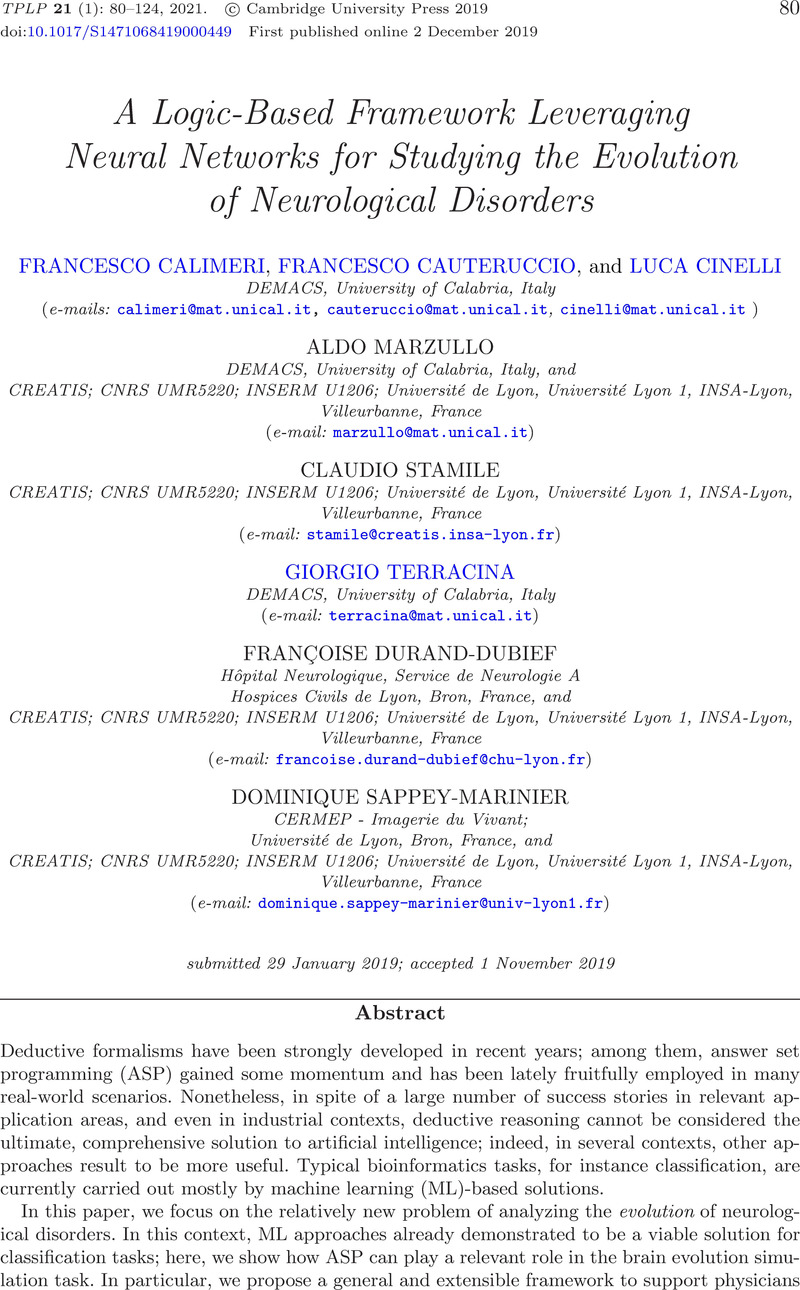Crossref Citations
This article has been cited by the following publications. This list is generated based on data provided by Crossref.
Segato, Alice
Marzullo, Aldo
Calimeri, Francesco
and
De Momi, Elena
2020.
Artificial intelligence for brain diseases: A systematic review.
APL Bioengineering,
Vol. 4,
Issue. 4,
Bruno, Pierangela
Calimeri, Francesco
Marte, Cinzia
and
Manna, Marco
2021.
Rules and Reasoning.
Vol. 12851,
Issue. ,
p.
95.
Aoki, Sorama
Fujimori, Juichi
Mikami, Ryoko
Hoshi, Kenji
Kawakami, Junko
Sato, Kenichi
and
Nakashima, Ichiro
2021.
Assisting the diagnosis of multiple sclerosis using a set of regional brain volumes: A classification model for patients and healthy controls.
Informatics in Medicine Unlocked,
Vol. 26,
Issue. ,
p.
100766.
Basile, Valerio
Cauteruccio, Francesco
and
Terracina, Giorgio
2021.
How Dramatic Events Can Affect Emotionality in Social Posting: The Impact of COVID-19 on Reddit.
Future Internet,
Vol. 13,
Issue. 2,
p.
29.
Lazovskaya, Tatiana
Tarkhov, Dmitriy
Chistyakova, Maria
Razumov, Egor
Sergeeva, Anna
and
Shemyakina, Tatiana
2023.
Evolutionary PINN Learning Algorithms Inspired by Approximation to Pareto Front for Solving Ill-Posed Problems.
Computation,
Vol. 11,
Issue. 8,
p.
166.
Farajzadeh, Nacer
Sadeghzadeh, Nima
and
Hashemzadeh, Mahdi
2023.
Brain tumor segmentation and classification on MRI via deep hybrid representation learning.
Expert Systems with Applications,
Vol. 224,
Issue. ,
p.
119963.
Jiji, G. Wiselin
Rajesh, A.
and
Lakshmi, M. Maha
2023.
Diagnosis of Parkinson’s disease using EEG and fMRI.
Multimedia Tools and Applications,
Vol. 82,
Issue. 10,
p.
14915.
Varanasi, Srinivas
and
Malathi, K.
2023.
Self-improved COOT optimization-based LSTM for patient waiting time prediction.
Multimedia Tools and Applications,
Mohapatra, Sulagna
Sahoo, Prasan Kumar
and
Mohapatra, Suvendu Kumar
2023.
Healthcare Big Data Analysis with Artificial Neural Network for Cardiac Disease Prediction.
Electronics,
Vol. 13,
Issue. 1,
p.
163.
Swamidorai, Sindhuja
Murthy, T Satyanarayana
and
Sriharsha, K V
2023.
Translating natural language questions to SQL queries (nested queries).
Multimedia Tools and Applications,
Li, Haichen
Li, Jianghai
and
Li, Zhandong
2023.
Quantitative Scale Analysis of the Channel Bar in a Braided River and Its Internal Architecture.
Applied Sciences,
Vol. 14,
Issue. 1,
p.
257.
Thandapani, Sujithra
Mahaboob, Mohamed Iqbal
Iwendi, Celestine
Selvaraj, Durai
Dumka, Ankur
Rashid, Mamoon
and
Mohan, Senthilkumar
2023.
IoMT with Deep CNN: AI-Based Intelligent Support System for Pandemic Diseases.
Electronics,
Vol. 12,
Issue. 2,
p.
424.
Golumbic, Yaela N.
Scroggie, Kymberley R.
Kenneally, Ciara R.
Lin, Jiarun
Blyth, Mitchell T.
Firmer, Genevieve
Rutledge, Peter J.
and
Motion, Alice
2023.
Meet the Medicines—A Crowdsourced Approach to Collecting and Communicating Information about Essential Medicines Online.
International Journal of Environmental Research and Public Health,
Vol. 20,
Issue. 5,
p.
4242.
Masood, Isma
Daud, Ali
Wang, Yongli
Banjar, Ameen
and
Alharbey, Riad
2024.
A blockchain-based system for patient data privacy and security.
Multimedia Tools and Applications,






